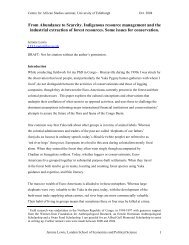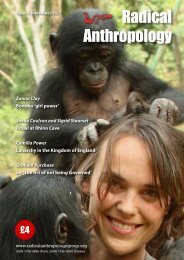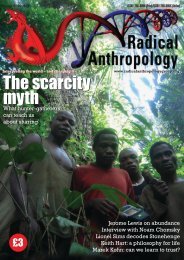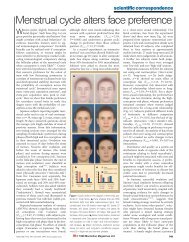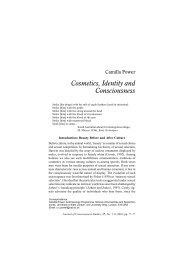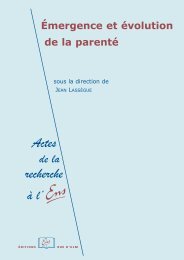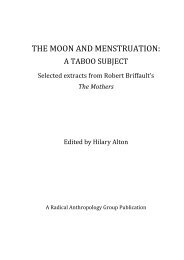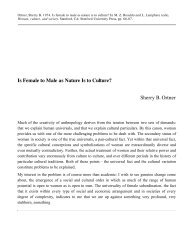Language and life history: A new perspective on the development ...
Language and life history: A new perspective on the development ...
Language and life history: A new perspective on the development ...
- No tags were found...
You also want an ePaper? Increase the reach of your titles
YUMPU automatically turns print PDFs into web optimized ePapers that Google loves.
Commentary/Locke & Bogin: <str<strong>on</strong>g>Language</str<strong>on</strong>g> <str<strong>on</strong>g>and</str<strong>on</strong>g> <str<strong>on</strong>g>life</str<strong>on</strong>g> <str<strong>on</strong>g>history</str<strong>on</strong>g>1990). Pidgins are protolanguages used by people from differentlinguistic backgrounds who are brought toge<strong>the</strong>r to live <str<strong>on</strong>g>and</str<strong>on</strong>g>work, whereas creoles are true languages. More c<strong>on</strong>vincing yetof children’s collective ability to invent language comes from agenerati<strong>on</strong> of deaf Nicaraguans who had not been exposed to adeveloped language <str<strong>on</strong>g>and</str<strong>on</strong>g> who, prior to attending a <str<strong>on</strong>g>new</str<strong>on</strong>g> schoolfor <strong>the</strong> deaf, communicated using idiosyncratic home-signsystems. Shortly after arriving at <strong>the</strong> school, <strong>the</strong>se home signersdeveloped a shared system of signs <str<strong>on</strong>g>and</str<strong>on</strong>g> grammatical devices.This shared system developed into a full-fledged sign languageafter several years <str<strong>on</strong>g>and</str<strong>on</strong>g> several cohorts of typically young, deafindividuals without <strong>the</strong> need for instructi<strong>on</strong>s or adult models(Senghas & Coppola 2001; Senghas et al. 2004).The emergence of <str<strong>on</strong>g>new</str<strong>on</strong>g> skills, such as language or its antecedents,in a group of individuals can place <strong>the</strong>m in novel c<strong>on</strong>texts<str<strong>on</strong>g>and</str<strong>on</strong>g> expose <strong>the</strong>m to <str<strong>on</strong>g>new</str<strong>on</strong>g> selecti<strong>on</strong> pressures. This would surelyhave been <strong>the</strong> case with <strong>the</strong> emergence of language <str<strong>on</strong>g>and</str<strong>on</strong>g> itsunderlying symbolic abilities. We argue, as have o<strong>the</strong>rs (e.g.,Gottlieb 2002; Lickliter & Schneider, in press; West-Eberhard2003), that <strong>the</strong> neural plasticity of infants <str<strong>on</strong>g>and</str<strong>on</strong>g> children <str<strong>on</strong>g>and</str<strong>on</strong>g><strong>the</strong>ir behavioral <str<strong>on</strong>g>and</str<strong>on</strong>g> cognitive resp<strong>on</strong>ses to novel envir<strong>on</strong>mentsprovide much of <strong>the</strong> stuff up<strong>on</strong> which natural selecti<strong>on</strong> works,<str<strong>on</strong>g>and</str<strong>on</strong>g> that this may have been especially important in recenthuman cognitive evoluti<strong>on</strong> (e.g., Bjorklund 2006). Such plasticitymay c<strong>on</strong>tinue to afford <strong>the</strong> opportunity for phylogeneticchange in Homo sapiens. For instance, <strong>the</strong> Flynn effect, asteady rise in IQ (particularly fluid intelligence) over <strong>the</strong> pastcentury, may be due to accelerated cognitive <strong>development</strong>(Howard 2001), perhaps in resp<strong>on</strong>se to an increasingly visualenvir<strong>on</strong>ment (see Neisser 1988). We do not believe that <strong>the</strong>human race is <strong>on</strong> <strong>the</strong> verge of a radical evoluti<strong>on</strong>ary change;but <strong>the</strong> neural plasticity evident in c<strong>on</strong>temporary childrenin resp<strong>on</strong>se to changing envir<strong>on</strong>ments likely also characterizedour ancestors <str<strong>on</strong>g>and</str<strong>on</strong>g> c<strong>on</strong>tributed centrally to <strong>the</strong> emergenceof language <str<strong>on</strong>g>and</str<strong>on</strong>g> related sociocognitive abilities in ourforechildren.Rec<strong>on</strong>ciling vague <str<strong>on</strong>g>and</str<strong>on</strong>g> formal models oflanguage evoluti<strong>on</strong>Henry Bright<strong>on</strong>, Rui Mata, <str<strong>on</strong>g>and</str<strong>on</strong>g> Andreas WilkeCenter for Adaptive Behavior <str<strong>on</strong>g>and</str<strong>on</strong>g> Cogniti<strong>on</strong>, Max Planck Institute for HumanDevelopment, 14195 Berlin, Germany.hbright<strong>on</strong>@mpib-berlin.mpg.de http://www.ling.ed.ac.uk/henryb mata@mpib-berlin.mpg.de http://www-abc.mpibberlin.mpg.de/users/matawilke@mpib-berlin.mpg.dehttp://www-abc.mpib-berlin.mpg.de/users/wilkeAbstract: One way of dealing with <strong>the</strong> pro<str<strong>on</strong>g>life</str<strong>on</strong>g>rati<strong>on</strong> of c<strong>on</strong>jecturesthat accompany <strong>the</strong> diverse study of <strong>the</strong> evoluti<strong>on</strong> of language is todevelop precise <str<strong>on</strong>g>and</str<strong>on</strong>g> testable models which reveal o<strong>the</strong>rwise latentimplicati<strong>on</strong>s. We suggest how verbal <strong>the</strong>ories of <strong>the</strong> role of individual<strong>development</strong> in language evoluti<strong>on</strong> can benefit from formal modeling,<str<strong>on</strong>g>and</str<strong>on</strong>g> vice versa.Research into <strong>the</strong> evoluti<strong>on</strong> of language is growing rapidly <str<strong>on</strong>g>and</str<strong>on</strong>g> itsstudy now cuts across several disciplines. Despite <strong>the</strong> diversesources of insight which make up this field of study, few woulddisagree that underst<str<strong>on</strong>g>and</str<strong>on</strong>g>ing how <str<strong>on</strong>g>and</str<strong>on</strong>g> why our species-specificlinguistic communicati<strong>on</strong> system came to be, requires a c<strong>on</strong>siderati<strong>on</strong>of <strong>the</strong> interacti<strong>on</strong>s am<strong>on</strong>g three processes: biological evoluti<strong>on</strong>,linguistic evoluti<strong>on</strong>, <str<strong>on</strong>g>and</str<strong>on</strong>g> individual <strong>development</strong> (e.g.,Christiansen & Kirby 2003b). C<strong>on</strong>sequently, we were pleasedto see Locke & Bogin’s (L&B’s) target article focus <strong>on</strong> <strong>on</strong>eoften-neglected comp<strong>on</strong>ent – individual <strong>development</strong> – <str<strong>on</strong>g>and</str<strong>on</strong>g> itsrelati<strong>on</strong> to biological evoluti<strong>on</strong>. However, in order to underst<str<strong>on</strong>g>and</str<strong>on</strong>g><strong>the</strong> implicati<strong>on</strong>s of a <strong>the</strong>ory of individual <strong>development</strong> <str<strong>on</strong>g>and</str<strong>on</strong>g> itsrelati<strong>on</strong>ship to <strong>the</strong> evoluti<strong>on</strong> of language, we must go bey<strong>on</strong>dvague models whose implicati<strong>on</strong>s are hard to gauge <str<strong>on</strong>g>and</str<strong>on</strong>g> movetowards more formal <str<strong>on</strong>g>and</str<strong>on</strong>g> testable models.Dominating <strong>the</strong> study of language evoluti<strong>on</strong> is <strong>the</strong> desire tounderst<str<strong>on</strong>g>and</str<strong>on</strong>g> <strong>the</strong> unique form of structural complexity we see inhuman language. In o<strong>the</strong>r words, we seek an explanati<strong>on</strong> ofhow certain forms of complexity arise from an initial statewhere that complexity was lacking. As L&B discuss, language isa communicati<strong>on</strong> system used in many interesting <str<strong>on</strong>g>and</str<strong>on</strong>g> uniqueways. However, it is misleading to assume that by studying <strong>the</strong>communicative uses to which language is put we can gaininsight into why language is so structurally distinct from o<strong>the</strong>rcommunicati<strong>on</strong> systems. L&B emphasize that language is usedto support functi<strong>on</strong>s which c<strong>on</strong>tribute to an individuals’ reproductivesuccess. However, <strong>the</strong> degree to which <strong>the</strong> specific structureof language is required for such functi<strong>on</strong>ing is by no meansclear. First, although most organisms communicate, <str<strong>on</strong>g>and</str<strong>on</strong>g> thosethat do so effectively are likely to be at an advantage over thosethat do not, <strong>on</strong>ly <strong>on</strong>e species has language. Sec<strong>on</strong>d, <strong>on</strong>e canimagine many c<str<strong>on</strong>g>and</str<strong>on</strong>g>idate communicati<strong>on</strong> systems that fulfillsuch requirements. Fur<strong>the</strong>rmore, language arguably does afairly bad job as a communicati<strong>on</strong> system (e.g., Chomsky et al.2002). In sum, <strong>the</strong> evoluti<strong>on</strong> of language cannot be explainedby its communicative functi<strong>on</strong> al<strong>on</strong>e.To fully underst<str<strong>on</strong>g>and</str<strong>on</strong>g> language <str<strong>on</strong>g>and</str<strong>on</strong>g> its emergence we have tounderst<str<strong>on</strong>g>and</str<strong>on</strong>g> <strong>the</strong> interacting adaptive systems that have driven itsevoluti<strong>on</strong>. An important tool in this endeavor is <strong>the</strong> use offormal modeling, which allows us to explore <strong>the</strong> implicati<strong>on</strong>s ofprecise <str<strong>on</strong>g>and</str<strong>on</strong>g> testable hypo<strong>the</strong>ses. The growing interest in <strong>the</strong>evoluti<strong>on</strong> of language has been accompanied (some might sayspurred) by an upturn in ma<strong>the</strong>matical <str<strong>on</strong>g>and</str<strong>on</strong>g> computati<strong>on</strong>almodels (e.g., Briscoe 2002; Cangelosi & Parisi 2001; Hurford1989; 2005; Kirby 2002; Nowak & Komarova 2001).We would like to highlight how formal approaches to studying<strong>the</strong> evoluti<strong>on</strong> of language can profit from fur<strong>the</strong>r c<strong>on</strong>siderati<strong>on</strong> of<strong>the</strong> process of individual <strong>development</strong>. First, <strong>development</strong> is acrucial step in determining <strong>the</strong> class of acquirable communicati<strong>on</strong>systems. The <strong>on</strong>togenetic <strong>development</strong> of <strong>the</strong> cognitivemachinery resp<strong>on</strong>sible for processing languages may be tied tostages in <strong>the</strong> <str<strong>on</strong>g>life</str<strong>on</strong>g> course, <str<strong>on</strong>g>and</str<strong>on</strong>g> this <strong>development</strong>al path is likelyto be crucial to underst<str<strong>on</strong>g>and</str<strong>on</strong>g>ing <strong>the</strong> structural characteristics oflanguage. For example, computati<strong>on</strong>al modeling of languageacquisiti<strong>on</strong> has shown <strong>the</strong> importance of c<strong>on</strong>sidering howlanguage structure relates to cognitive systems <str<strong>on</strong>g>and</str<strong>on</strong>g> <strong>the</strong>ir <strong>development</strong>.Elman (1993) used neural network simulati<strong>on</strong>s to showhow networks can learn certain forms of linguistic structure ifmemory is started small <str<strong>on</strong>g>and</str<strong>on</strong>g> <strong>the</strong>n gradually exp<str<strong>on</strong>g>and</str<strong>on</strong>g>ed. Thismirrors <strong>the</strong> <strong>development</strong> of short-term memory capacity inhumans <str<strong>on</strong>g>and</str<strong>on</strong>g> suggests that <strong>the</strong> mind may be tuned to develop inparticular ways to facilitate learning. Elman’s work dem<strong>on</strong>strateshow <strong>the</strong> maturati<strong>on</strong>al trajectory over an agent’s <str<strong>on</strong>g>life</str<strong>on</strong>g>time canimpact <strong>on</strong> what is <str<strong>on</strong>g>and</str<strong>on</strong>g> what is not ultimately acquirable. Fur<strong>the</strong>rmore,<strong>the</strong> particular form of inductive bias that defines <strong>the</strong>language learner has a knock-<strong>on</strong> effect when we c<strong>on</strong>siderwhich kinds of structure can withst<str<strong>on</strong>g>and</str<strong>on</strong>g> repeated culturaltransmissi<strong>on</strong> (Bright<strong>on</strong> et al. 2005b; Smith 2004).Sec<strong>on</strong>d, individual <strong>development</strong> is characterized not <strong>on</strong>ly bychanges in cognitive aspects but also in social aspects, such as<strong>the</strong> structure of social networks. The social networks in which adeveloping individual is situated impacts <strong>on</strong> how language istransmitted between generati<strong>on</strong>s (e.g., Kerswill & Williams2000; Ragir 2002). If c<strong>on</strong>straints <strong>on</strong> how language is transmittedfrom <strong>on</strong>e generati<strong>on</strong> to <strong>the</strong> next impact significantly <strong>on</strong><strong>the</strong> distributi<strong>on</strong> of linguistic forms (e.g., statistical universals;for a discussi<strong>on</strong> see Bright<strong>on</strong> et al. 2005a), <strong>the</strong>n <strong>the</strong> socialnetworks through which language is transmitted are likely toplay a significant role (Smith & Hurford 2003). Hence, <strong>the</strong>implicati<strong>on</strong>s of changing social networks that L&B discusscould be explored by investigating how <strong>the</strong>y impact, over acultural timescale, <strong>on</strong> <strong>the</strong> distributi<strong>on</strong> of language’s structuralcharacteristics.282 BEHAVIORAL AND BRAIN SCIENCES (2006) 29:3



